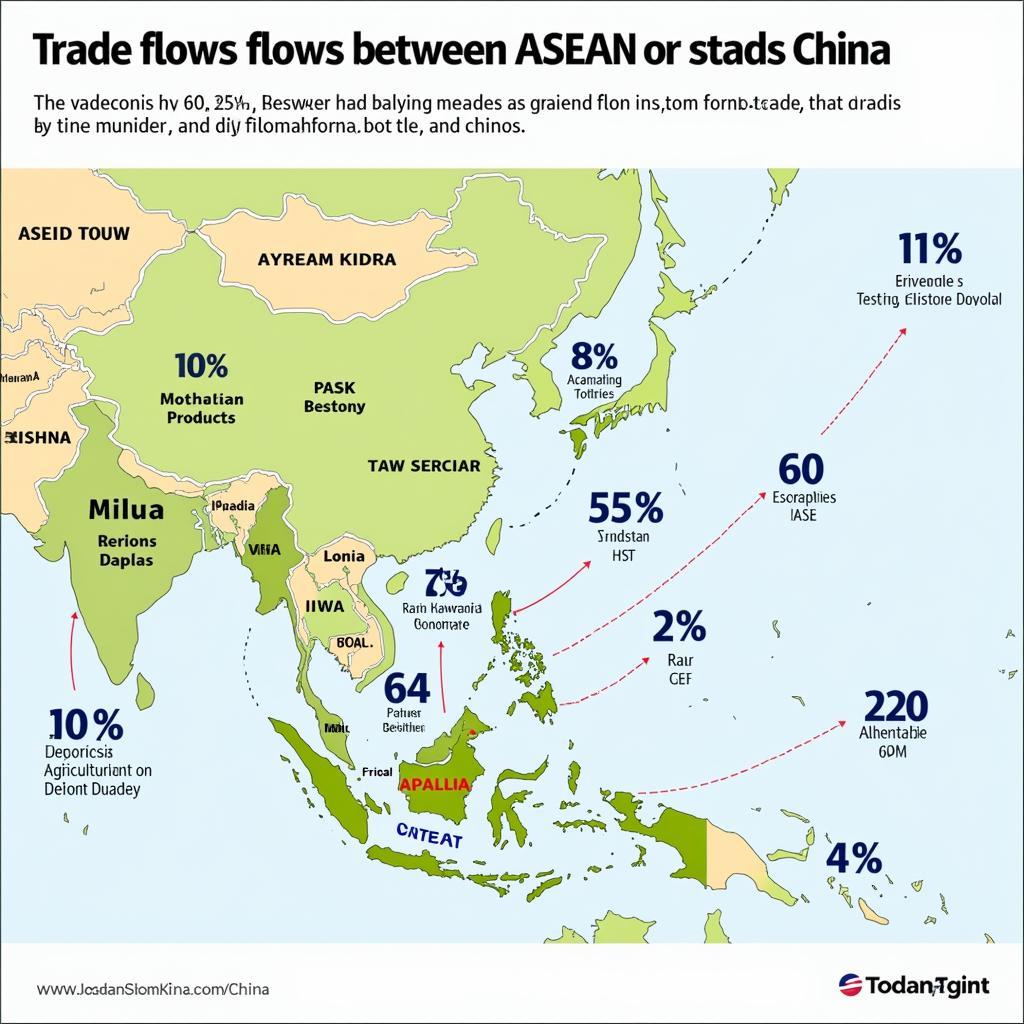Asean And China Economic Relations have deepened significantly over the past few decades, transforming the regional landscape. From trade and investment to infrastructure development and tourism, the two economies have become increasingly intertwined, creating a complex web of interdependence. This partnership, while mutually beneficial, also presents unique challenges and opportunities for both sides.
A Deep Dive into ASEAN-China Trade
Trade has been the cornerstone of ASEAN and China economic relations. China has been ASEAN’s largest trading partner for over a decade, and ASEAN has also risen to become a key trading partner for China. This robust trade relationship is driven by a number of factors, including geographical proximity, complementary economies, and favorable trade agreements. The ASEAN-China Free Trade Area (ACFTA), established in 2010, has played a crucial role in eliminating tariffs and promoting trade liberalization. This agreement has facilitated the flow of goods and services, boosting economic growth in both regions.
 ASEAN-China Trade Flows: A visualization of the growing trade relationship between ASEAN and China, highlighting key sectors and trade volumes.
ASEAN-China Trade Flows: A visualization of the growing trade relationship between ASEAN and China, highlighting key sectors and trade volumes.
The Impact of the Belt and Road Initiative
China’s Belt and Road Initiative (BRI) has further strengthened ASEAN and China economic relations by fostering infrastructure development and connectivity across the region. Numerous BRI projects, including ports, railways, and highways, are underway in ASEAN countries, improving logistics and facilitating trade. These projects not only enhance physical connectivity but also stimulate economic activity and create jobs. However, the BRI has also faced scrutiny regarding debt sustainability and environmental impact, posing challenges for ASEAN nations.
Investment Flows: A Two-Way Street
Investment flows between ASEAN and China have also witnessed significant growth. Chinese companies are increasingly investing in ASEAN countries, particularly in sectors such as manufacturing, infrastructure, and technology. Conversely, ASEAN investment in China is also on the rise, albeit at a slower pace. This two-way investment flow fosters economic integration and promotes technological transfer, benefiting both regions.
Navigating the Challenges
While ASEAN and China economic relations have brought numerous benefits, they also face challenges. Concerns about trade imbalances, market access, and intellectual property protection need to be addressed. Furthermore, the South China Sea dispute remains a sensitive issue that could potentially disrupt economic cooperation. Effective communication and dialogue are crucial for managing these challenges and ensuring a stable and mutually beneficial partnership.
What’s Next for ASEAN and China Economic Relations?
The future of ASEAN and China economic relations looks promising. Both sides are actively exploring new avenues for cooperation, including in areas such as digital economy, e-commerce, and sustainable development. The Regional Comprehensive Economic Partnership (RCEP), which includes both ASEAN and China, is expected to further boost trade and investment. As the two economies become increasingly integrated, it is crucial to foster a balanced and inclusive partnership that benefits all stakeholders.
Conclusion: A Dynamic Partnership in the Making
ASEAN and China economic relations are a dynamic and evolving story. The deepening economic ties have transformed the region, creating opportunities for growth and development. While challenges remain, the commitment to cooperation and mutual benefit is evident. By addressing these challenges and exploring new avenues for collaboration, ASEAN and China can forge a stronger and more sustainable partnership that contributes to regional prosperity and stability. This continued engagement will shape the future economic landscape of Asia and beyond. As ASEAN and China economic relations continue to evolve, staying informed and understanding the complexities of this partnership is crucial for navigating the changing global economic landscape.
FAQ
- What is ACFTA? (Answer: The ASEAN-China Free Trade Area is a free trade agreement that eliminates tariffs and promotes trade between ASEAN countries and China.)
- What is the Belt and Road Initiative? (Answer: The BRI is a Chinese infrastructure development strategy that aims to connect Asia, Europe, and Africa through infrastructure projects.)
- What are some of the challenges in ASEAN-China economic relations? (Answer: Challenges include trade imbalances, market access issues, and the South China Sea dispute.)
- How does RCEP impact ASEAN-China relations? (Answer: RCEP further strengthens trade and investment ties by creating a larger free trade area.)
- What is the future of ASEAN-China economic relations? (Answer: The future looks promising, with potential for further cooperation in areas like the digital economy and sustainable development.)
See also: ASEAN Affairs, ASEAN and BRICS, Aims and Purposes of ASEAN Plus Three, 15th India ASEAN Summit, ASEAN China Expo
For further information or support, please contact us at: Phone: 0369020373, Email: aseanmediadirectory@gmail.com or visit us at: Thôn Ngọc Liễn, Hiệp Hòa, Bắc Giang, Việt Nam. We have a 24/7 customer support team.
